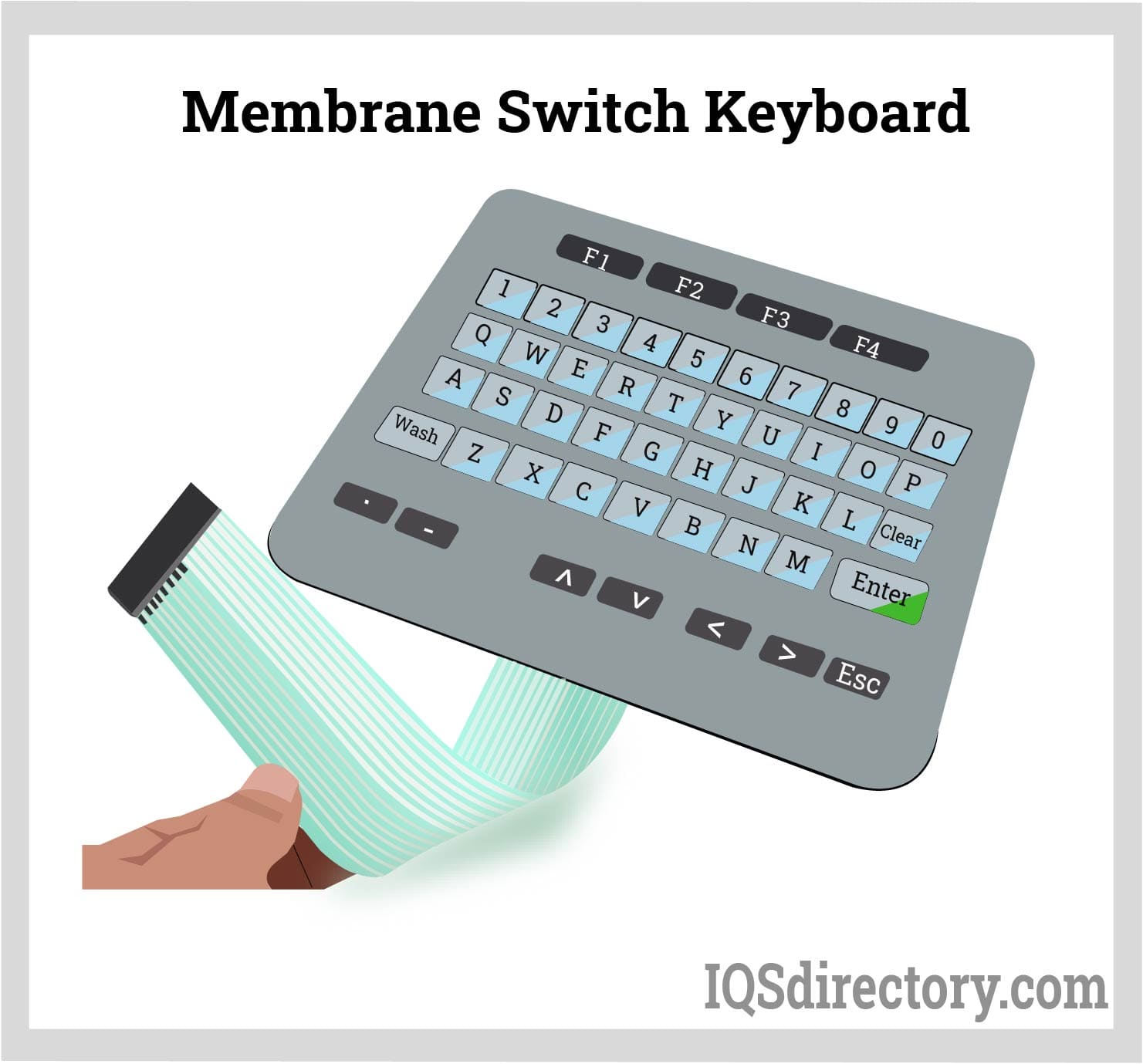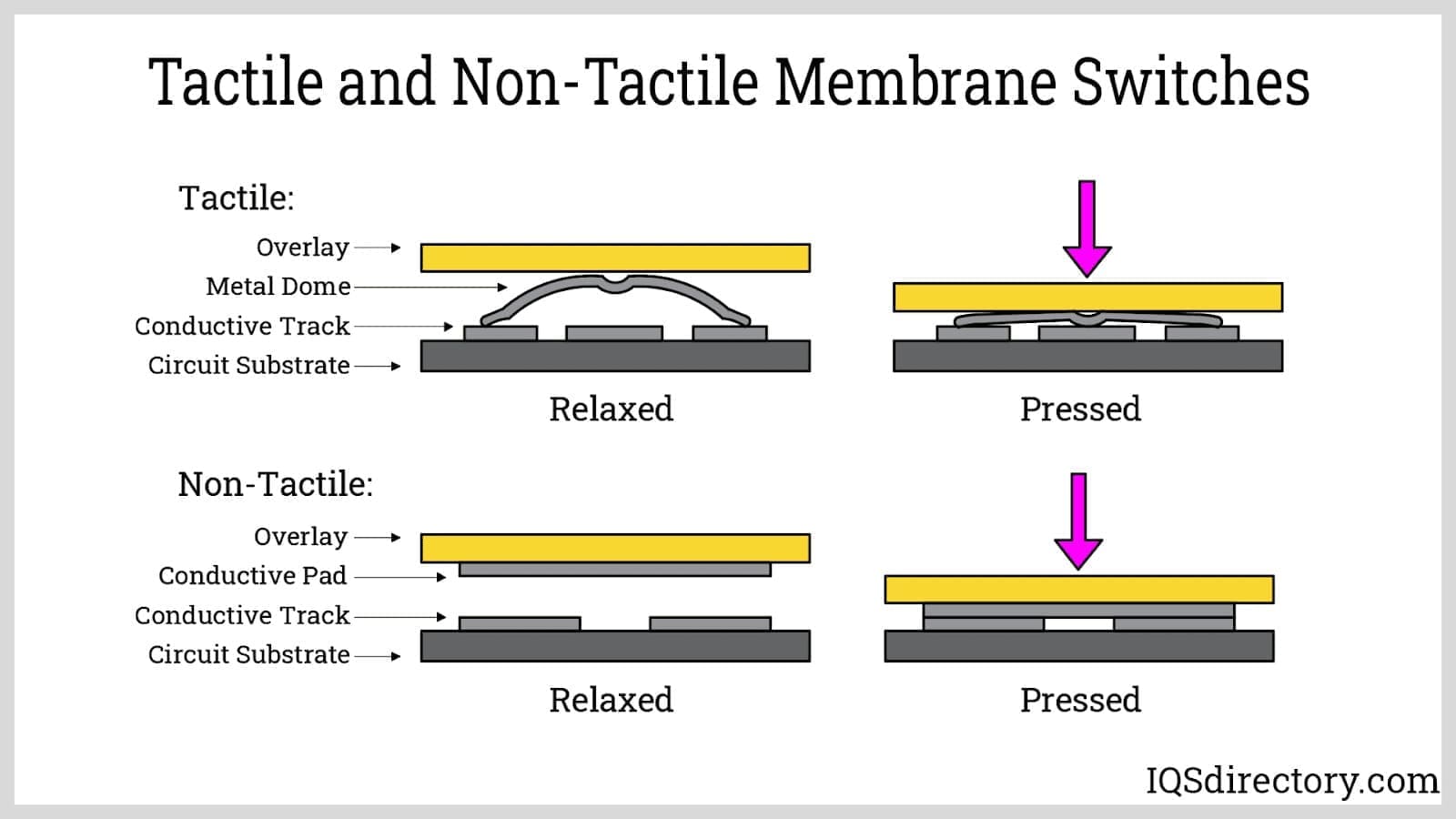All About Membrane Switch Over: A Comprehensive Overview for Beginners
Membrane switches are vital elements in modern-day electronics, offering an one-of-a-kind interface for customer communication - membrane switch. Their layered building and construction, including overlays and conductive traces, supplies performance and toughness. Unlike standard mechanical switches, membrane buttons present a smooth layout and adjustable options. Understanding their crucial attributes and advantages can transform product design. Nevertheless, the intricacies of their application and style factors to consider necessitate additional exploration
What Is a Membrane Switch?
A membrane button is a kind of electric button that contains a versatile membrane layered over a printed motherboard. This design permits for a compact and streamlined user interface, typically used in numerous digital tools. Membrane layer switches are commonly found in customer devices, medical equipment, and industrial equipment because of their longevity and resistance to ecological factors.The construction generally includes multiple layers, such as visuals overlays and glue backing, which provide responsive comments and protect the wiring underneath. The operation of a membrane button is launched when pressure is related to the surface area, completing an electrical circuit.These switches are valued for their adaptability, allowing custom-made designs and printed graphics that accommodate certain user interfaces. Their inconspicuous nature reduces space needs, making them perfect for applications where typical buttons may not fit. On the whole, membrane layer buttons offer a practical and visual remedy for contemporary electronic tools.
Key Components of Membrane Switches
Membrane switches comprise several crucial elements that contribute to their functionality and performance. The leading layer, known as the overlay, supplies the customer interface and is usually published with icons or graphics. Beneath the overlay lies a spacer layer, which divides the conductive elements and prevents unintentional activation. The next crucial component is the visuals layer, which improves looks and ensures the resilience of the design.Conductive traces, usually made from products like silver or carbon, are printed on the circuit layer. When stress is put on the overlay, these traces come right into get in touch with, finishing the circuit. Furthermore, a backing layer provides architectural assistance and can be made from products such as polyester or polycarbonate. With each other, these parts produce a trustworthy, straightforward interface appropriate for various applications, from house appliances to commercial tools. Understanding these elements is necessary for anybody curious about membrane button innovation.
Exactly How Membrane Changes Work
Recognizing just how membrane layer switches over function is important for valuing their prevalent usage in numerous gadgets. A membrane button runs through a series of layers, including a visuals overlay, spacer, and a circuit layer. When pressure is put on the overlay, it compresses the spacer layer, allowing the circuit layer to make get in touch with and complete an electric circuit. This activity sends a signal to the tool, triggering an action, such as transforming on a light or turning on a function.Membrane switches over can be made with different functions, including responsive feedback, backlighting, and customized graphics, enhancing individual interaction. Their building and construction allows for a sealed layout, safeguarding the interior components from dust, wetness, and contaminants. This toughness makes them appropriate for diverse applications, from customer electronic devices to commercial tools. In general, the simpleness and performance of membrane layer changes contribute to their appeal in modern-day innovation.
Advantages of Membrane Layer Switches Mechanical Buttons
While mechanical buttons have long been a staple in several gadgets, membrane changes deal unique benefits that make them progressively appealing. One substantial benefit is their slim profile, allowing for more portable designs and greater flexibility in item growth. Furthermore, membrane layer switches over feature an uniform surface area, which improves visual charm and simplifies cleansing, making them suitable for settings where hygiene is critical.Another advantage is their resistance to dust and wetness. Unlike mechanical buttons, which can be jeopardized by environmental aspects, membrane switches offer a sealed user interface that safeguards against contaminants - membrane switch. Additionally, membrane buttons typically have a longer life-span due to fewer moving components, causing boosted durability and reliability.Cost-effectiveness is likewise a significant advantage, as membrane switches can be produced wholesale with reduced production prices. These elements combine to place membrane buttons as a sensible choice to typical mechanical choices in various applications
Usual Applications of Membrane Switches
Membrane layer switches are widely made use of in numerous markets, specifically in customer electronics and commercial control board. In consumer gadgets, they give a smooth, easy to use user interface, while in commercial setups, they boost sturdiness and capability. Understanding these applications highlights the flexibility and usefulness of membrane layer buttons in contemporary technology.
Consumer Electronics Devices
As consumer electronics remain to develop, membrane switches have actually ended up being a preferred option for a range of gadgets due to their versatility and sleek style. These buttons are frequently found in smartphones, tablet computers, and push-button controls, where area is limited and aesthetics issue. Their low profile and personalized layouts allow makers to create easy to use interfaces that boost the total customer experience. In addition, membrane layer switches are frequently used in appliances such as microwaves and coffee machine, offering intuitive control options while resisting moisture and dust. The durability and dependability of membrane layer switches over make them ideal for daily customer products, guaranteeing long life and constant performance. In general, their combination in consumer electronic devices mirrors a blend of performance and modern-day design.
Industrial Control Panels
The applications of membrane layer changes prolong beyond consumer electronics, locating substantial usage in industrial control panels. These switches are preferred for their longevity and resistance to extreme environments, making them ideal for making and process control settings. They offer a dependable user interface for operators to manage machinery, display procedures, and readjust settings. Membrane layer buttons can be personalized to match details operational needs, integrating functions like backlighting and responsive feedback, improving individual experience. Their inconspicuous style enables combination right into different devices, while their capability to stand up to spills, dust, and severe temperature levels warranties long life. Overall, membrane layer buttons add to reliable and risk-free procedure in industrial applications, showing their versatility and performance in demanding environments.
Factors To Consider for Designing Membrane Layer Switches
When designing membrane layer buttons, selecting the appropriate products is vital to ensure toughness see post and functionality. Furthermore, comprehending layer setup methods see page can substantially influence the button's performance and individual experience. These considerations play an important duty in producing effective and dependable membrane button layouts.
Material Option Relevance
Material option plays an important duty in the design and performance of membrane layer switches. The chosen materials straight affect the button's sturdiness, tactile reaction, and total visual. Trick considerations consist of the substrate, which must provide architectural honesty while enabling flexibility, and the graphic overlay, which requires to be resistant to put on and environmental elements. Conductive products ought to ensure reliable electric efficiency, while adhesives should supply strong bonding without jeopardizing the button's operation. Furthermore, compatibility with manufacturing processes and end-user settings is crucial; materials must withstand differing temperatures, humidity degrees, and chemical exposure. Ultimately, ideal material choice not just improves the membrane layer button's efficiency yet also adds to its long life and individual contentment, making it a crucial aspect of the design procedure.

Layer Setup Methods

Often Asked Inquiries
The Length Of Time Do Membrane Switches Commonly Last?
Membrane switches typically have a life-span of 1 to 5 million cycles, the original source depending on usage and ecological problems. Elements such as design high quality and operating frequency greatly influence their durability and overall efficiency long life.

Can Membrane Layer Switches Be Custom-made for Certain Styles?
Membrane buttons can indeed be customized to accommodate certain designs, permitting varied shapes, colors, and performances. This convenience allows suppliers to tailor these switches to satisfy distinct aesthetic and operational demands efficiently.
What Products Are Made Use Of in Membrane Layer Change Building And Construction?
Membrane layer buttons are commonly constructed utilizing products such as polyester, polycarbonate, and adhesive layers. These materials offer versatility, durability, and resistance to ecological variables, making sure the buttons work effectively in different applications and problems.
Are Membrane Layer Changes Immune or water resistant to Dampness?
Membrane layer buttons can be made to be moisture-resistant, utilizing specialized finishes and products. Their water-proof abilities depend on construction high quality and details applications, making it necessary to analyze requirements for optimal performance in different settings.
How Are Membrane Layer Switches Over Repaired if Harmed?
Repairing broken membrane layer switches over normally entails changing the affected layer or circuit. Professionals may additionally apply conductive sticky or utilize specialized repair work packages, ensuring performance is recovered without full substitute of the whole button assembly. Unlike standard mechanical buttons, membrane buttons offer a smooth layout and personalized options. A membrane button is a kind of electrical button that is composed of a flexible membrane layer layered over a printed circuit board. The operation of a membrane switch is launched when pressure is used to the surface area, completing an electric circuit.These buttons are valued for their convenience, enabling custom styles and published graphics that provide to certain user interfaces. While mechanical buttons have long been a staple in numerous devices, membrane layer changes deal unique benefits that make them progressively appealing. Membrane layer switches usually have a longer life-span due to fewer relocating parts, resulting in enhanced longevity and reliability.Cost-effectiveness is likewise a notable advantage, as membrane layer switches can be produced in mass with lower manufacturing expenses.